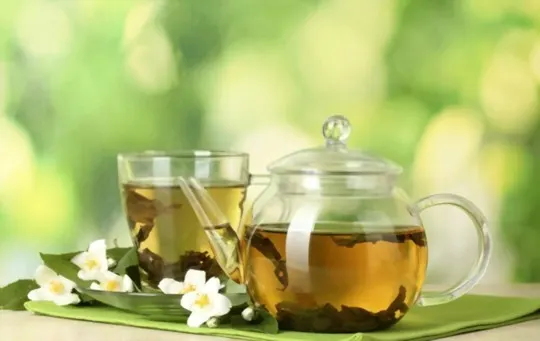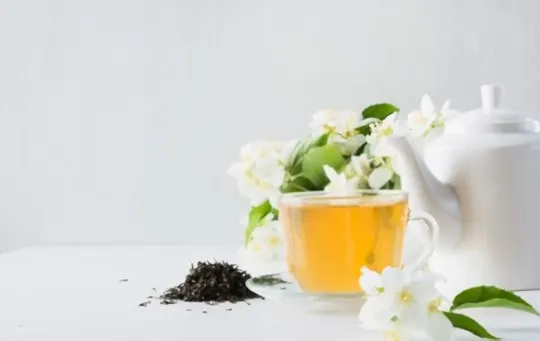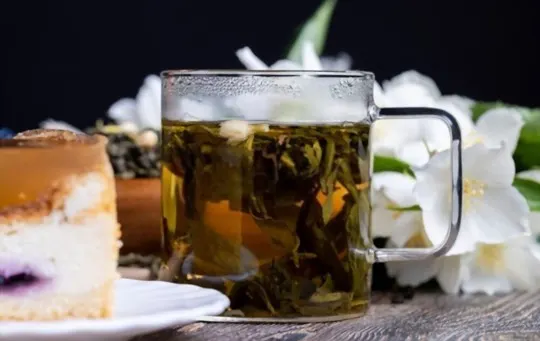In the universe of teas, green tea is a superstar. Then, jasmine green tea sashays in, adding a floral twist. We all know the perks of green tea – hello, antioxidants! But toss some jasmine flowers into the mix, and you’ve got a fragrant concoction that doubles as a spa for your senses.
We’ve been through our phases – coffee die-hards, herbal tea experimenters. Yet, here we are, circling back to green tea, now jazzed up with jasmine. It’s like that one friend who always knows how to make an entrance.
This isn’t just about a drink; it’s a mini-vacation in a cup. A sip that sends us on a brief holiday to a serene, blooming garden.

What is Jasmine Green Tea?

Jasmine green tea is a type of green tea that is scented with jasmine flowers, giving it a fragrant aroma and delicate sweetness.
Unlike regular green tea, which is simply dried leaves of the Camellia sinensis plant, jasmine green tea undergoes an additional process of being layered with fresh jasmine flowers.
As the tea leaves absorb the scent and flavor of the flowers, they become infused with a unique floral taste that sets them apart from traditional green teas.
In addition to its distinct flavor profile, jasmine green tea also offers potential health benefits attributed to green tea as a whole.
These benefits include antioxidant properties that may help reduce inflammation, improve heart health and potentially lower the risk of some types of cancer.
However, more research is needed to fully understand the effects of jasmine green tea specifically on human health.
Overall, for those seeking a delicately flavored alternative to traditional green teas, jasmine green tea may be worth considering.
Its unique sensory experience and potential health benefits make it a standout choice among other varieties of tea.
What is Green Tea?

Green tea is a type of tea that is made from the Camellia sinensis plant, commonly grown in China and Japan.
The leaves are steamed or pan-fried, which gives them their distinct flavor and color.
Green tea contains high levels of antioxidants and other beneficial compounds that have been linked to many health benefits.
Compared to its counterpart, Jasmine Green Tea is a type of green tea that has been infused with jasmine flowers.
This gives it a sweeter, more delicate flavor and aroma than regular green tea.
Some people also believe that jasmine green tea has additional health benefits due to the properties of the jasmine flower.
While both types of tea offer similar health benefits, such as improved brain function and lowered risk of heart disease, jasmine green tea may provide additional benefits due to the added properties of the jasmine flower infusion.
Ultimately, choosing between green tea and jasmine green tea comes down to personal preference in taste and aroma.
Both offer numerous health benefits and can be enjoyed either hot or cold.
Differences Between Jasmine Green Tea and Green Tea

Jasmine Green Tea versus Green Tea – What distinguishes them? Both teas come from the same plant, Camellia sinensis.
However, jasmine green tea leaves are infused with jasmine flowers while green tea is the pure and unadulterated form of Camellia sinensis leaves.
Despite their similarities in origin, there are some key differences between these two teas.
Jasmine green tea is more fragrant and has a flowery aroma compared to the grassy and earthy aroma of plain green tea.
Jasmine green tea also contains less caffeine than regular green tea but still provides similar health benefits such as antioxidants and improved brain function.
In addition to this, another significant difference is that jasmine green tea can be consumed by those who may not enjoy the taste of plain green tea due to its enchanting floral notes.
However, it does not mean that one particular type is superior to the other; it all depends on personal preference.
Processing Method
After plucking the tea leaves, different processing methods are applied to produce various tea types.
One common approach involves heat treatment of the leaves to prevent oxidation, retaining natural color and preserving taste.
Green teas undergo steaming, pan-frying or roasting procedures, whereas jasmine green teas undergo a unique layering process with fresh jasmine flowers.
The tea leaves absorb the fragrance of the flowers multiple times before harvesting, infusing a distinct aroma and flavor.
Jasmine green tea also contains higher levels of amino acids than regular green teas due to this processing method, providing potential health benefits.
However, excessive scenting can mask the original green tea taste and weaken its beneficial properties.
Flavor and Aroma
The Sensory Difference between Jasmine Green Tea and Green Tea.
Jasmine green tea is distinct from green tea in its aroma and flavor.
The floral scent of jasmine pairs well with the grassy, earthy notes of green tea.
This combination creates a refreshing taste that is less bitter than traditional green tea.
In addition to its flavor profile, brewing jasmine green tea can also be an invigorating sensory experience.
As the hot water steeped with the fragrant jasmine blossoms combines with the tea leaves, it releases a pleasant aroma into the surrounding air.
However, while both types of tea offer health benefits such as antioxidants and metabolism boosts, it’s essential to note that only jasmine green tea has fragrant mood-lifting properties that are often hailed for their soothing relaxation effects.
Caffeine Content
The amount of caffeine present in Jasmine Green Tea and Green Tea varies significantly.
The two may have a similar origin, but the presence of jasmine oils in Jasmine Green Tea provides it with a unique flavor that sets it apart from Green Tea.
The added aroma does not affect its caffeine level, which is relatively lower compared to its counterpart.
It’s important to note that the actual caffeine content in both teas will depend on several factors such as brewing method, leaf quality, and water temperature used.
However, on average, a cup of Jasmine Green Tea has about 25 milligrams of caffeine while a cup of green tea contains around 35 milligrams.
Jasmine Green Tea is recommended for those looking for a milder energy boost without experiencing the jitters associated with higher caffeine intake.
On the other hand, if you’re looking for an extra kick to start your day or stay alert, then green tea might be the better option with slightly more caffeine content.
Overall, both Jasmine Green Team and Green Tea offer numerous health benefits and remain popular choices among tea enthusiasts worldwide due to their unique flavors and aroma.
Health Benefits and Nutritional Profile
Green Tea and Jasmine Green Tea are two popular tea variations that have unique flavors and aromas.
In addition to their taste, they also offer various health benefits and nutritional profiles.
Let’s dive deeper into the differences and similarities between these teas.
- Both green tea and jasmine green tea are rich in antioxidants which help reduce the risk of chronic diseases such as cancer, diabetes, and heart disease.
- They both contain caffeine which can improve mental alertness, concentration, and mood.
- Green tea has higher amounts of catechins which are beneficial for weight loss, immune function, and reducing inflammation.
- Jasmine Green Tea has a calming effect due to its natural relaxing properties that promote relaxation and sleep.
- The nutritional profile of both teas is similar but the amount of flavonoids may vary depending on the manufacturing process.
- Green tea is unflavored while Jasmine Green Tea has a floral aroma with a delicate taste.
It’s important to note that individual results may vary depending on factors such as brewing method, frequency of consumption, age, lifestyle habits, and overall health status.
Therefore, before adding any new food or beverage to your diet it’s important to discuss it with a healthcare provider or registered dietitian.
In summary, both green tea and jasmine green tea offer numerous health benefits and unique flavor profiles.
Their nutritional value adds an additional level of complexity when deciding which one best suits your taste preferences or health needs.
Similarities Between Jasmine Green Tea and Green Tea

Jasmine Green Tea and Green Tea have many similarities in terms of their origin and processing.
Both teas are derived from the Camellia sinensis plant, which grows in Asia.
They are both made by picking the tea leaves, steaming or pan-frying them, and drying them out.
As a result, they both contain antioxidants and catechins that boost metabolism and support overall health.
When it comes to taste, both Jasmine Green Tea and Green Tea can be enjoyed hot or cold with or without sweeteners like honey or sugar.
However, Jasmine Green Tea has a distinctive floral aroma because of jasmine flowers infused during its production process.
This makes it an excellent choice for those who prefer a delicate flavor.
One unique detail is that while Green Tea has a higher caffeine content than Jasmine Green Tea, the difference is not significant enough to cause jitters or anxiety in most people.
Additionally, both teas have been linked to numerous health benefits like reducing the risk of chronic diseases such as cancer and heart disease.
Brewing Methods for Jasmine Green Tea and Green Tea
Brewing Techniques for Jasmine Green Tea and Green Tea.
Jasmine green tea and green tea are both popular beverages with distinct brewing techniques.
Here is a guide to prepare both these teas:
- Heat water in a kettle or pot until it starts boiling.
- Place the required amount of loose green tea leaves or tea bags into a teapot.
- Pour the hot water over the leaves and let it steep for around 2-3 minutes.
- Strain the brewed liquid into another container when the desired flavor strength is achieved.
The distinctive aroma of jasmine green tea comes from jasmine flowers, and thus, requires an additional step before adding green tea leaves to it:
- Place dried jasmine flowers in a jar and add green tea leaves to it.
- Let the mix sit overnight so that the jasmine scent seeps into the green tea leaves.
Popular Varieties and Brands of Jasmine Green Tea and Green Tea
Jasmine Green Tea and Green Tea have their own unique varieties and brands.
Some popular varieties of Jasmine Green Tea are Dragon Phoenix Pearls, Silver Needle, and Chun Hao.
On the other hand, Green Tea has popular varieties such as Matcha, Sencha, and Gunpowder.
When it comes to brands, some famous brands of Jasmine Green Tea are Harney & Sons, Teavivre, and Rishi Tea Co.
While for Green Tea, well-known brands are Bigelow, Lipton, and Twinings.
It is important to note that Jasmine Green Tea is distinct from regular green tea due to its infused jasmine aroma thanks to its flowers being mixed in with the leaves during processing.
As a result of this infusion process, it has a soothing floral fragrance and taste that makes it a popular choice.
Another difference between the two teas is their caffeine content.
Jasmin green tea tends to have less caffeine than traditional green tea because the scenting process can reduce its caffeine content as well.
Conclusion
Green tea and jasmine green tea share similar health benefits, but their flavors and aromas distinguish them from each other.
Green tea has a grassy, earthy flavor while jasmine green tea offers a sweet, floral taste with a delicate aroma.
Both teas contain antioxidants that aid in reducing inflammation and promoting cardiovascular health.
However, the addition of jasmine flowers to green tea offers additional benefits such as stress relief and relaxation due to its calming properties.
Ultimately, the choice between regular green tea or jasmine green tea comes down to personal preference and desired health benefits.

Leave a comment